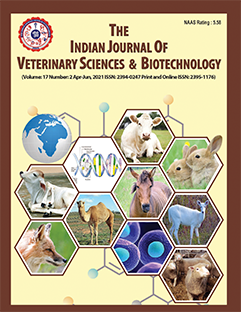Prevalence of Different Types of Enteritis in Camels of Rajasthan
DOI:
https://doi.org/10.48165/ijvsbt.21.5.033Keywords:
Camel, Enteritis, Intestine, RajasthanAbstract
For the present study, a total 80 tissue specimens of intestinal tract were examined from carcasses of camel, irrespective of sex, age groups and breeds, from July 2017 to June 2018. Out of these, 32 samples representative of gross lesions were processed for subsequent histopathological examination. An overall incidence of enteritis in camel was recorded as 40 % (32/80). The occurrence of various types of enteritis, i.e., catarrhal enteritis, necrotic enteritis, necro-haemorrhagic enteritis, eosinophilic enteritis and haemorrhagic enteritis were 15.00, 6.25, 6.25, 5.00 and 7.50 %, respectively. Catarrhal enteritis was the most prevalent and eosinophilic enteritis least prevalent conditions affecting intestines of camels in Rajasthan during the study period.
Downloads
References
Ahmed, Z. A. M. (2004). The role of Clostridium perfringens in camel calf diarrhoea with special reference to the pathogenesis and pathology in the Sudan. Ph.D. Thesis, University of Khartoum, Sudan.
Alhendi, A. A. (2000). Common diseases of camels (Camelus dromedarius) in eastern province of Saudi Arabia. Pakistan Veterinary Journal, 20(2), 97–99.
Asopa, S., Rani, S., Dadhich, H., Joshi, A., & Sharma, S. (2015). Incidence and histopathological observations of colibacillosis in intestine of buffalo calves. Indian Journal of Veterinary Science and Biotechnology, 11(2), 28–30.
Boukert, R., Chikhaoui, M., Saidj, D., Baaissa, B., Damene, H., Benali, S., Hussain, A. S. A., & Sahraoui, N. (2024). Histopathological investigation and risk factors of coccidiosis in camels (Camelus dromedarius), Algeria. Emirates Journal of Food and Agriculture, 36, 1–11.
Damir, H. A., Eldirdiri, N. I., Adam, S. E. I., Howarth, J. A., Salih, Y. M., & Idris, O. F. (1993). Experimental copper poisoning in the camel (Camelus dromedarius). Journal of Comparative Pathology, 108(2), 191–208.
Hammad, H., Fayza, A. O., Shamat, A. M., Hussein, K. S. M., Ishraga, G. I., & Salwa, M. A. K. (2007). Organophosphate and carbamate insecticides poisoning in the dromedary camel (Camelus dromedarius) in North Kordofan State, Sudan. Sudan Journal of Veterinary Research, 22, 71–77.
Jubb, K. V. F., Kennedy, P. C., & Palmer, N. C. (2007). Pathology of Domestic Animals (5th ed.). Academic Press, New York and London.
Khan, A., Saleemi, M. K., Ali, F., Abubakar, M., Hussain, R., Abbas, R. Z., & Khan, I. A. (2018). Pathophysiology of peste des petits ruminants in sheep (Dorper & Kajli) and goats (Boer & Beetal). Microbial Pathogen, 117, 139–147.
Kheirandish, R., Nourollahi-Fard, S. R., & Faryabi, Z. (2012). Prevalence and pathologic study of Eimeria cameli in slaughtered camels. Eurasian Journal of Veterinary Sciences, 28(3), 138–141.
Kumar, S., Rani, S., Dadhich, H., & Mathur, M. (2015). Types, pattern and morphology of enteritis prevalent in camels of Rajasthan. Journal of Camel Practice and Research, 22(2), 289–293.
Lillie, R. D. (1965). Histopathological Technique and Practical Histochemistry. McGraw Hill Book Company, New York and London.
Mehta, S. C., Bissa, U. K., Chirania, B. L., & Patil, N. V. (2012). Mortality analysis and herd growth in Indian dromedary breeds. Journal of Camel Practice and Research, 19(1), 37–44.
Moghaddar, N., Oryan, A., Gorjipour, S., & Akbari, M. A. (2010). Studies on seasonal prevalence and clinico-pathology of gastrointestinal helminths of camel (Camelus dromedarius) in Iran with special reference to Nematodirinae nematodes. Journal of Camel Practice and Research, 17(2), 147–150.
Moselhy, A. A., & El-Ghazali, H. M. (2023). Gross histological and electron microscopical features of the hard palate mucosa in the one-humped camel (Camelus dromedarius). Iraqi Journal of Veterinary Sciences, 37(3), 651–657.
Mubarak, A. G., Khalifa, F. A., Elsobky, Y., Abdel-Rady, A., Felefel, W., Saad, A. H., Abdelhiee, E. Y., Alhassan, A. M., Awny, H., Elghazaly, E. M., & Abu-Seida, A. M. (2024). Sudden death due to enterotoxemia among Arabian camels (Camelus dromedarius) and associated risk factors. Open Veterinary Journal, 14(8), 1942–1951.
Nour-Mohammadzadeh, F., Seyed, Z. B., Hesaraki, S., Yadegari, Z., Alidadi, N., Tabrizi, S. S., & Springer. (2010). Septicemic salmonellosis in a two-humped camel calf (Camelus bactrianus). Tropical Animal Health and Production, 42(8), 1601–1604.
Sastry, G. A., & Rao, P. R. (2005). Veterinary Pathology (7th ed.). CBS Publishers and Distributors, Shahdara, Delhi, India.
Tafti, A. K., Makeki, M., & Oryan, A. (2001). Pathological study of intestines and mesenteric lymph nodes of camels slaughtered in Iran. Journal of Camel Practice and Research, 8(2), 209–213.
Zheng, X., Cheng, J., Pan, K., Yang, K., Wang, H., & Wu, E. (2008). Eosinophilic enteritis CT features. Abdominal Imaging, 33(2), 191–195.
Downloads
Published
Issue
Section
License
Copyright (c) 2025 Indian Journal of Veterinary Sciences and Biotechnology

This work is licensed under a Creative Commons Attribution-NonCommercial-NoDerivatives 4.0 International License.




